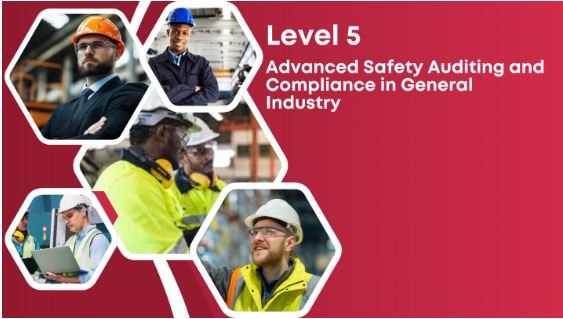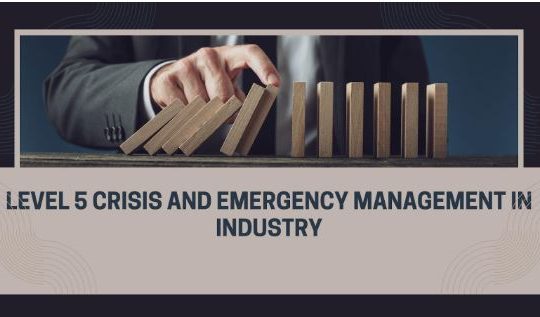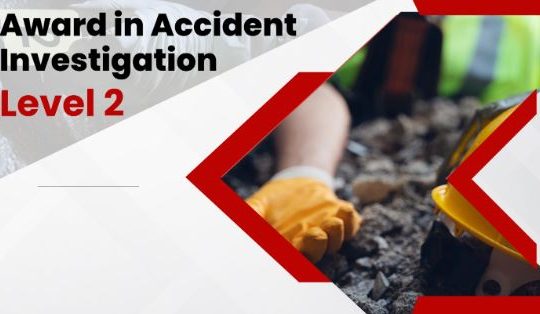
Level 5 Advanced Safety Auditing and Compliance in General Industry
Course Overview
The Level 5 Advanced Safety Auditing and Compliance in General Industry course is designed for safety professionals and managers who aim to lead and manage comprehensive safety audits across diverse industries. This advanced qualification provides participants with the expertise to conduct in-depth safety audits, ensure regulatory compliance, and identify opportunities for safety improvements. The course focuses on advanced auditing techniques, legal frameworks, and the development of strategies to enhance workplace safety and efficiency.
Benefits
- Comprehensive Auditing Skills: Master the ability to conduct detailed safety audits across multiple industries.
- Enhanced Compliance Knowledge: Gain a deep understanding of regulatory requirements and how to meet them effectively.
- Improved Workplace Safety: Identify and mitigate safety risks, creating a safer work environment.
- Career Growth Opportunities: Develop specialized skills that position you for leadership roles in health and safety management.
- Organizational Value: Contribute to enhanced operational efficiency and reduced liability through effective compliance strategies.
Learning Outcomes
Upon completing this course, participants will be able to:
- Conduct advanced-level safety audits and identify compliance gaps in general industry.
- Interpret and apply relevant health and safety regulations, codes, and standards.
- Develop and implement corrective action plans to address non-compliance and safety risks.
- Utilize modern auditing tools and techniques to ensure efficient and effective assessments.
- Prepare comprehensive audit reports and communicate findings to stakeholders.
Study Units
- Introduction to Safety Auditing
- Purpose and principles of safety auditing.
- Types of audits and their applications in general industry.
- Understanding Compliance Requirements
- Overview of legal and regulatory frameworks.
- Common compliance challenges in general industry.
- Auditing Tools and Techniques
- Advanced tools such as checklist-based and risk-based auditing.
- Digital solutions for safety auditing and data analysis.
- Conducting Effective Safety Audits
- Planning, executing, and documenting audits.
- Engaging with stakeholders during the auditing process.
- Corrective Actions and Continuous Improvement
- Developing corrective and preventive action plans (CAPA).
- Promoting a culture of continuous safety improvement.
- Reporting and Communication
- Writing detailed and actionable audit reports.
- Presenting findings and recommendations effectively.
Career Progression
The Level 5 Advanced Safety Auditing and Compliance in General Industry opens doors to high-level roles such as:
- Health and Safety Manager: Lead compliance initiatives and oversee safety programs.
- Auditing Specialist: Conduct advanced audits and implement safety improvements.
- Compliance Officer: Ensure adherence to industry-specific safety regulations.
- Risk Management Consultant: Advise organizations on minimizing safety risks and enhancing compliance.
- Safety Trainer or Consultant: Educate teams on effective auditing practices and compliance standards.
Our assessment process is designed to ensure every learner achieves the required level of knowledge, skills, and understanding outlined in each course unit.
Purpose of Assessment
Assessment helps measure how well a learner has met the learning outcomes. It ensures consistency, quality, and fairness across all learners.
What Learners Need to Do
Learners must provide clear evidence that shows they have met all the learning outcomes and assessment criteria for each unit. This evidence can take different forms depending on the course and type of learning.
Types of Acceptable Evidence
Assignments, reports, or projects
Worksheets or written tasks
Portfolios of practical work
Answers to oral or written questions
Test or exam papers
Understanding the Structure
Learning outcomes explain what learners should know, understand, or be able to do.
Assessment criteria set the standard learners must meet to achieve each learning outcome.
Assessment Guidelines
All assessment must be authentic, current, and relevant to the unit.
Evidence must match each assessment criterion clearly.
Plagiarism or copied work is not accepted.
All learners must complete assessments within the given timelines.
Where applicable, assessments may be reviewed or verified by internal or external quality assurers.
Full learning outcomes and assessment criteria for each qualification are available from page 8 of the course handbook.
Top Courses
No results found.
Related Courses
Let's Get in touch
Deleting Course Review
Course Access
This course is password protected. To access it please enter your password below:



